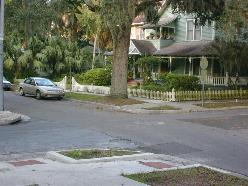By Dom Nozzi
When I think about designing or testing a street for greatness, I generally ask three questions:
1. Is the street charmingly human-scaled?
A great street, for me, features a very modest street width from curb to curb. The “curb radius” of the intersection is also essential. One of the most  common crashes experienced by someone walking across an intersection is a person who is struck by a right-turning vehicle at the intersection. A wide (large) curb radius typically induces high-speed turning movements by motorists. Creating a turning (curb) radius which results in a tight turn movement by the vehicle will reduce turning speeds, and shortens the crossing distance for the person walking.
common crashes experienced by someone walking across an intersection is a person who is struck by a right-turning vehicle at the intersection. A wide (large) curb radius typically induces high-speed turning movements by motorists. Creating a turning (curb) radius which results in a tight turn movement by the vehicle will reduce turning speeds, and shortens the crossing distance for the person walking.
A street with charm and human scale also features an uninterrupted fabric of permeable, 24-hour buildings, which creates a sense of enclosure by butting up to the sidewalk. On-street parking layers both sides of the street. Added (and often quite important) bonuses are a framing canopy of street trees, and a street that is brick or cobblestone. Very little is more effective in creating romantic charm than brick or cobblestone.
2. Does the street design obligate well-behaved motorist travel?
In my opinion, there is very little that is more important for city street design than obligating slower-speed, attentive, patient, courteous driving by motorists. For these reasons, I tend to enthusiastically endorse traffic engineer Hans Monderman’s naked streets concept. The lack of well-behaved of driving, when streets are not designed to obligate such driving, is exceptionally toxic to cities.
Because of this, my favorite streets tend to be give-way streets. Two-way streets (with on-street parking) are so narrow that motorists are compelled to drive slowly, attentively, and courteously.
3. Is the street a complete street?
Obviously, a great street should be designed to create transportation choices. A “complete street” is one that is designed to be used comfortably, conveniently and safely by all forms of travel.
4. Is the street regularly active?
A great street should contain large volumes of pedestrians and bicyclists throughout the day and night. Such regular activity makes the street enjoyable, sociable, and safe.
Sure, there are great streets that don’t score well on these three questions. But I am convinced that they are great despite this.
______________________________________________
Visit my urban design website read more about what I have to say on those topics. You can also schedule me to give a speech in your community about transportation and congestion, land use development and sprawl, and improving quality of life.
Visit: www.walkablestreets.wordpress.com
Or email me at: dom[AT]walkablestreets.com
 My memoir can be purchased here: Paperback = http://goo.gl/9S2Uab Hardcover = http://goo.gl/S5ldyF
My memoir can be purchased here: Paperback = http://goo.gl/9S2Uab Hardcover = http://goo.gl/S5ldyF
My book, The Car is the Enemy of the City (WalkableStreets, 2010), can be purchased here: http://www.lulu.com/product/paperback/the-car-is-the-enemy-of-the-city/10905607
My book, Road to Ruin, can be purchased here:
http://www.amazon.com/Road-Ruin-Introduction-Sprawl-Cure/dp/0275981290
My Adventures blog
http://domnozziadventures.wordpress.com/
Run for Your Life! Dom’s Dangerous Opinions blog
http://domdangerous.wordpress.com/
My Town & Transportation Planning website
http://walkablestreets.wordpress.com/
My Plan B blog
My Facebook profile
http://www.facebook.com/dom.nozzi
My YouTube video library
http://www.youtube.com/user/dnozzi
My Picasa Photo library
https://picasaweb.google.com/105049746337657914534
My Author spotlight
http://www.lulu.com/spotlight/domatwalkablestreetsdotcom


